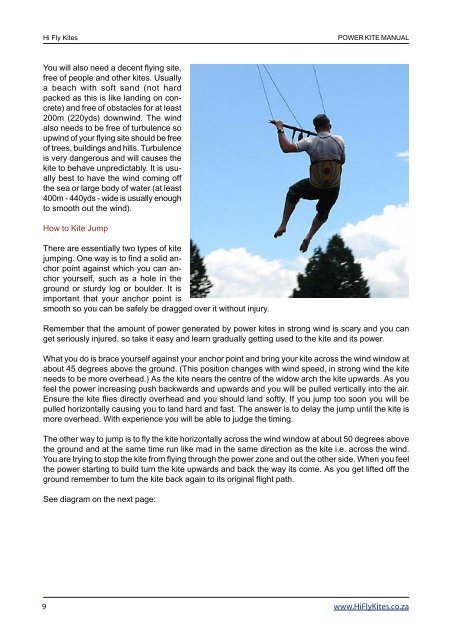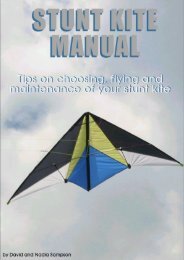Power Kite Guide. Flying A Power Kite Manual. - Hi Fly Kites
Power Kite Guide. Flying A Power Kite Manual. - Hi Fly Kites
Power Kite Guide. Flying A Power Kite Manual. - Hi Fly Kites
You also want an ePaper? Increase the reach of your titles
YUMPU automatically turns print PDFs into web optimized ePapers that Google loves.
<strong>Hi</strong> <strong>Fly</strong> <strong>Kite</strong>s<br />
You will also need a decent flying site,<br />
free of people and other kites. Usually<br />
a beach with soft sand (not hard<br />
packed as this is like landing on concrete)<br />
and free of obstacles for at least<br />
200m (220yds) downwind. The wind<br />
also needs to be free of turbulence so<br />
upwind of your flying site should be free<br />
of trees, buildings and hills. Turbulence<br />
is very dangerous and will causes the<br />
kite to behave unpredictably. It is usually<br />
best to have the wind coming off<br />
the sea or large body of water (at least<br />
400m - 440yds - wide is usually enough<br />
to smooth out the wind).<br />
How to <strong>Kite</strong> Jump<br />
There are essentially two types of kite<br />
jumping. One way is to find a solid anchor<br />
point against which you can anchor<br />
yourself, such as a hole in the<br />
ground or sturdy log or boulder. It is<br />
important that your anchor point is<br />
smooth so you can be safely be dragged over it without injury.<br />
9<br />
POWER KITE MANUAL<br />
Remember that the amount of power generated by power kites in strong wind is scary and you can<br />
get seriously injured, so take it easy and learn gradually getting used to the kite and its power.<br />
What you do is brace yourself against your anchor point and bring your kite across the wind window at<br />
about 45 degrees above the ground. (This position changes with wind speed, in strong wind the kite<br />
needs to be more overhead.) As the kite nears the centre of the widow arch the kite upwards. As you<br />
feel the power increasing push backwards and upwards and you will be pulled vertically into the air.<br />
Ensure the kite flies directly overhead and you should land softly. If you jump too soon you will be<br />
pulled horizontally causing you to land hard and fast. The answer is to delay the jump until the kite is<br />
more overhead. With experience you will be able to judge the timing.<br />
The other way to jump is to fly the kite horizontally across the wind window at about 50 degrees above<br />
the ground and at the same time run like mad in the same direction as the kite i.e. across the wind.<br />
You are trying to stop the kite from flying through the power zone and out the other side. When you feel<br />
the power starting to build turn the kite upwards and back the way its come. As you get lifted off the<br />
ground remember to turn the kite back again to its original flight path.<br />
See diagram on the next page:<br />
www.<strong>Hi</strong><strong>Fly</strong><strong>Kite</strong>s.co.za



